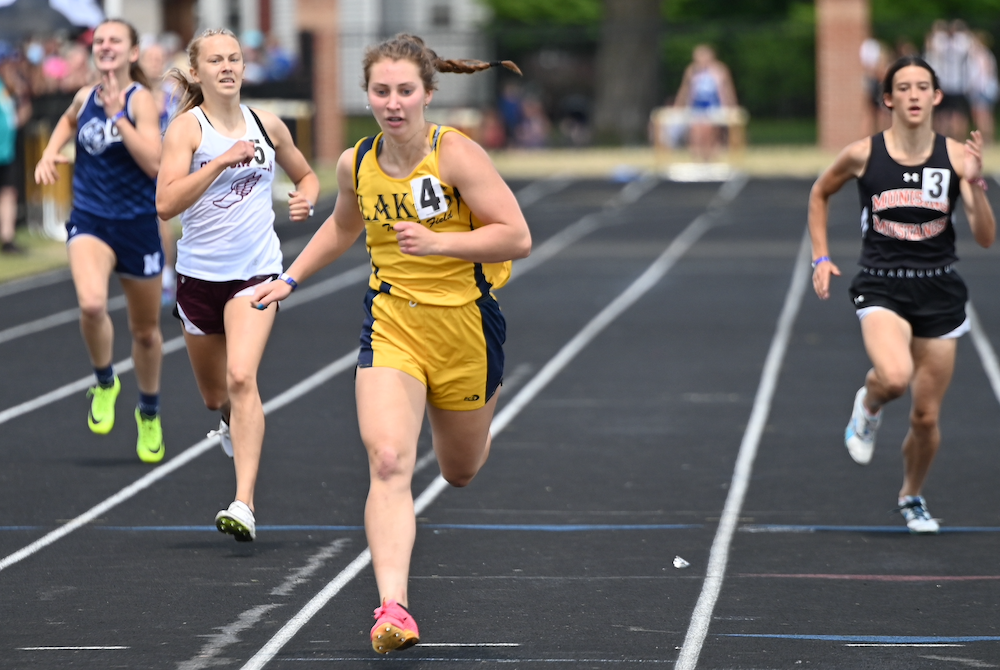
Lake Linden-Hubbell, Stephenson Share in UPD3; Jokela Joins Elite Club
By
Jason Juno
Special for MHSAA.com
June 4, 2023
KINGSFORD – Lake Linden-Hubbell got to the top with first-place power. Stephenson won only two events.
But there are multiple ways to win an MHSAA Finals championship in track & field. And the Lakes and Eagles tied for the Upper Peninsula Division 3 girls title Saturday.
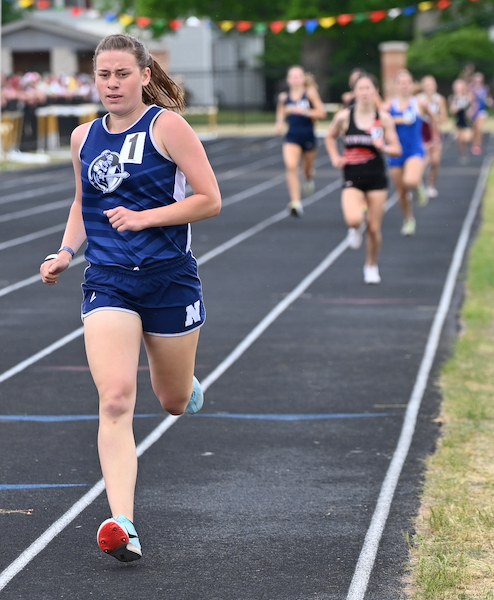 Lake Linden-Hubbell got a little assist from two-time reigning champion Ontonagon in the final event, the 1,600 relay. The Lakes led in the standings by eight points, but they didn’t have a 1,600-meter relay team. Stephenson could have won the team title with a win in that event, but Ontonagon’s relay team proved solid again and forced the Eagles to settle for the runner-up spot in the race and the eight points that come with it.
Lake Linden-Hubbell got a little assist from two-time reigning champion Ontonagon in the final event, the 1,600 relay. The Lakes led in the standings by eight points, but they didn’t have a 1,600-meter relay team. Stephenson could have won the team title with a win in that event, but Ontonagon’s relay team proved solid again and forced the Eagles to settle for the runner-up spot in the race and the eight points that come with it.
The Lakes last won team Finals titles during a three-year run from 2017-19. For Stephenson, it had been since 1993 when the team competed in Class C. The Eagles were runners-up last year.
Lake Linden-Hubbell sophomore Emily Jokela entered with the fastest Regional times in all four of her events, and she won all four of them Saturday – the 100, 200, 400 and 300 hurdles. She became just the sixth female to win four individual events at an MHSAA Finals.
The only one she didn’t win a title in last year was the 100 dash; she has that now. The only school record she didn’t have going into Saturday was in the 200; she has that now as well. She broke it by one tenth of a second.
“It feels great,” Jokela said. “I was very worried about running today because it was so hot.”
Her 300 hurdles time of 45.63 seconds set a UPD3 Finals record. Ontonagon’s Lori Wardynski had the record before (47.27).
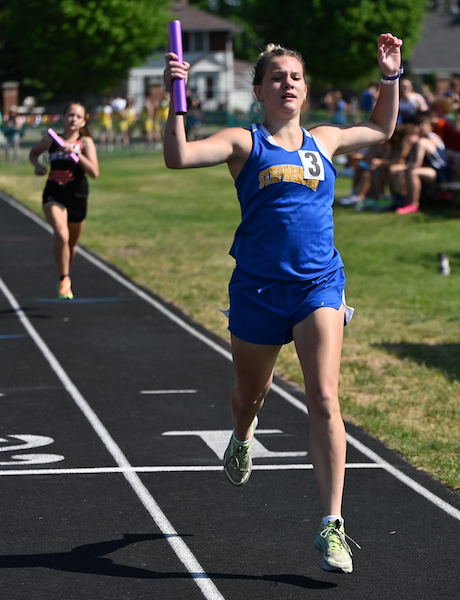 Teammate Abi Codere repeated in the 100 hurdles, and their 400 relay team (Codere, Rebecca Lyons, Isabella Tampas and Cleo Milkey) also won.
Teammate Abi Codere repeated in the 100 hurdles, and their 400 relay team (Codere, Rebecca Lyons, Isabella Tampas and Cleo Milkey) also won.
Stephenson’s wins came in the 3,200 relay (Faith Cappaert, Joelle Beaudo, Kayela Putnam and Jada Kuntze) and the long jump (Sarah Labs).
Ontonagon also won the 800 relay (Lilly McIntyre, Alli Bobula, Kylee Uotila and Makennah Uotila).
“I’m sad we didn’t get a title this year, but the past two back-to-back U.P. titles we had made my entire career,” senior Makennah Uotila said. “I’ve enjoyed it so much. The relays were a big part of our U.P. titles, so to still have strong relays is very important.”
Newberry’s Kaylen Clark won the 1,600 and 3,200 runs. She was the runner-up at the UPD3 cross country meet in the fall and in both events at the UPD2 track meet last season. Taylor Adams of Norway won the 800.
In the field, Mariska Laurila of Carney-Nadeau was the champion in the discus, Rudyard’s Alicia Cheney won the high jump, Dollar Bay’s Nora Keranen won the pole vault after winning long jump in 2022, and Brimley’s Grace Hill repeated in the shot put.
PHOTOS (Top) Lake Linden-Hubbell's Emily Jokela, second from right, wins the 400 on Saturday. (Middle) Norway's Taylor Adams wins the 800. (Below) Stephenson's Jada Kuntze crosses the finish line first in the 3,200 relay. (Photos by Cara Kamps/RunMichigan.com.)
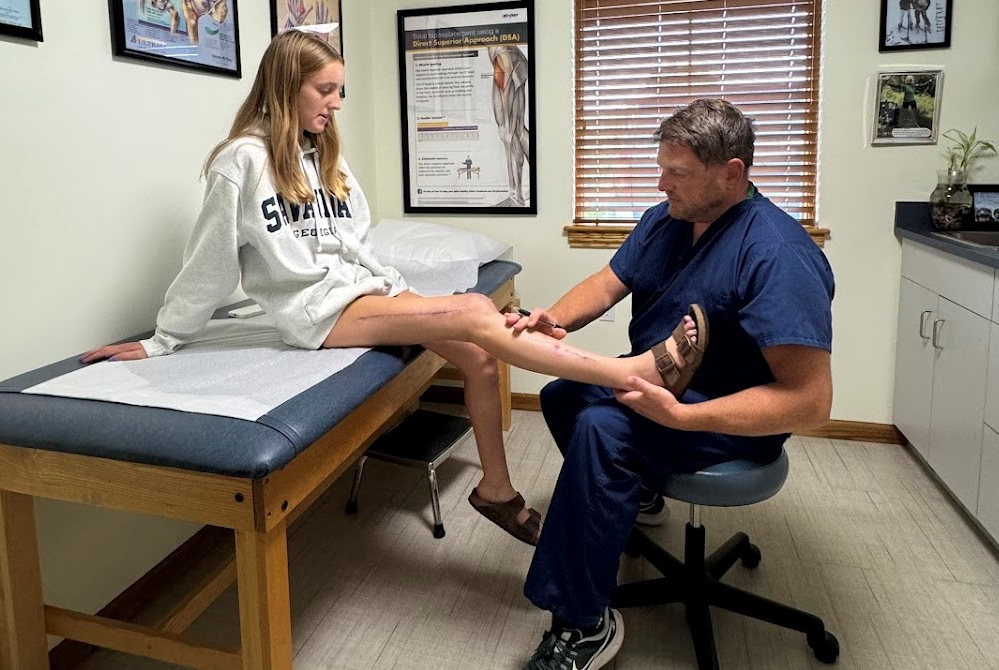
Elk Rapids' Smith Back on Course Just 2 Months After Severe Leg Injury
By
Tom Spencer
Special for MHSAA.com
August 30, 2024
Leighton Smith’s freshman year was nothing short of amazing as she competed for Elk Rapids High School’s first girls golf team in the fall and capped it off in the spring with a track school record and bragging rights as the fastest 400-meter runner in Northern Michigan.
 But events this summer were even more astonishing.
But events this summer were even more astonishing.
A horse riding accident in June left the 15-year-old fighting for her life, experiencing multiple surgeries and then recovering through physical therapy.
To top it off, she returned to the links Thursday representing the Elks at the Petoskey Invitational played at the Bay View Country Club. Smith shot a 100 as the Elks placed seventh. Her score was tied for the team’s best and featured four pars.
It was an impressive next step, to say the least.
No one could have been prepared to endure what Smith experienced this summer. And no one could have been better prepared to do it than the Elks sophomore, according to doctors, her coaches and her parents.
She underwent five surgeries in six days. The first surgery was done by Dr. Justin Hollander and Munson Medical Center. Dr. Hollander placed a titanium rod in her right leg to stabilize a severe femur fracture.
Smith developed compartment syndrome, which is extremely painful and happens when there’s too much pressure around the muscles and that pressure restricts the flow of blood, fresh oxygen and nutrients to muscles and nerves. That pain and lying in a hospital bed began to impact her mental health but Smith and her parents, Melinda and Don Smith, knew she had the capacity to get through her complications.
 Medical personnel, including Dr. Hollander, were extremely impressed with her determination, drive and attitude throughout.
Medical personnel, including Dr. Hollander, were extremely impressed with her determination, drive and attitude throughout.
“When you’re in a situation like this you have try your hardest to keep the most positive mindset and thoughts you can, because the mentality you have is what is really going to affect how you handle the whole situation,” Leighton Smith said.
Following that first surgery, she underwent multiple life and limb-saving surgical procedures called fasciotomies in both Traverse City and Grand Rapids. A fasciotomy involves cutting fascia to relieve tension or pressure in order to treat the resulting loss of circulation in acute situations.
“I am not used to being in a bed against my will,” Smith noted. “I was stuck there – you don’t realize the things you take for granted until you’re stuck there like that.”
Don Smith also serves as co-coach of the Elks girls golf team with Mike Newhouse. He witnessed his daughter’s horse riding accident and was there every step of recovery.
He couldn’t be more thrilled about what he witnessed in Petoskey as a father or coach.
“It is great to see her back and looking forward to the future,” Don Smith said. “We went from time in the hospital where you’re scared to even hear what the answer was going to be about sports and anything in life, and to be able to participate in golf here two to three weeks into the season.”
The sophomore has received MHSAA approval to use a cart during competition as a medical necessity, and she may be able golf in enough events this fall to participate in her team’s Regional in Tawas and possibly qualify for the Lower Peninsula Division 3 Final in Battle Creek.
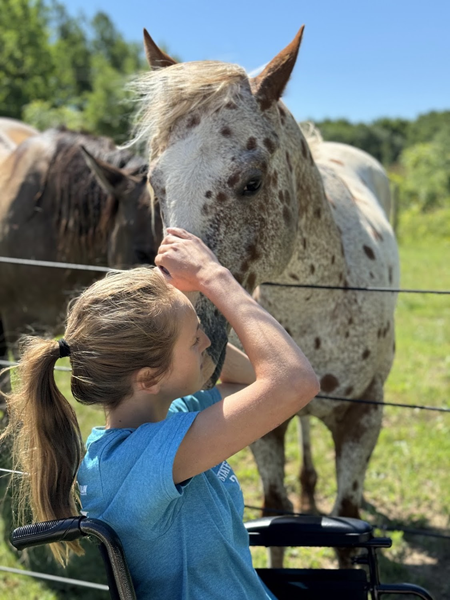 “Leighton has greatly exceeded my expectations,” Newhouse said. “I initially thought she might lose the season, and if she could get back by midseason it would be a slow return. But her performance today far exceeded anything I expected.”
“Leighton has greatly exceeded my expectations,” Newhouse said. “I initially thought she might lose the season, and if she could get back by midseason it would be a slow return. But her performance today far exceeded anything I expected.”
Golf really isn’t her favorite sport. Horse competition and track meets top that list. She is set to defend her 400-meter title next spring at the Traverse City Record-Eagle Honor Roll season-ending meet, and she is the only Elks student-athlete participating in rodeo, doing so through the Manton High School chapter of the Michigan High School Rodeo Association.
“I have a positive attitude and I don’t take it too seriously, but seriously enough that I can play the game,” she said of golf, while noting her primary motivation for being on the team is her father’s love of the game. “It is a good skill to have to be able to play golf, but it is definitely third on my list for sports.”
Third on the list is fine for her coaches.
“Dad will take it top three,” Don Smith noted while recalling moments after the final surgery at Helen DeVos Children’s Hospital. “The vascular surgeon talked with us for about 20 minutes and finally without us asking, he said she was going to be able to resume a normal life with sports and everything.”
And she has been back on a horse too.
“Now I am able to ride by myself pretty well, so I take him out every now and then and ride around the yard,” she said. “I think every time I get on, my Dad has a mini-heart attack – I think he’d prefer I never get on a horse again.”
 Tom Spencer is a longtime MHSAA-registered basketball and soccer official, and former softball and baseball official, and he also has coached in the northern Lower Peninsula area. He previously has written for the Saginaw News, Bay County Sports Page and Midland Daily News. He can be reached at tomspencer@chartermi.net with story ideas for Manistee, Wexford, Missaukee, Roscommon, Ogemaw, Iosco, Alcona, Oscoda, Crawford, Kalkaska, Grand Traverse, Benzie, Leelanau, Antrim, Otsego, Montmorency, Alpena, Presque Isle, Cheboygan, Charlevoix and Emmet counties.
Tom Spencer is a longtime MHSAA-registered basketball and soccer official, and former softball and baseball official, and he also has coached in the northern Lower Peninsula area. He previously has written for the Saginaw News, Bay County Sports Page and Midland Daily News. He can be reached at tomspencer@chartermi.net with story ideas for Manistee, Wexford, Missaukee, Roscommon, Ogemaw, Iosco, Alcona, Oscoda, Crawford, Kalkaska, Grand Traverse, Benzie, Leelanau, Antrim, Otsego, Montmorency, Alpena, Presque Isle, Cheboygan, Charlevoix and Emmet counties.
PHOTOS (Top) Leighton Smith, left, consults with Dr. Justin Hollander during her recovery from horse riding injuries this summer. (Middle) Smith tees up a drive for Elk Rapids this season. (Below) Smith shares a moment with her horse. (Photos provided by the Smith family.)

